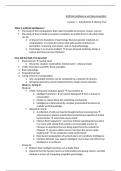Class notes
Lecture Summaries Artificial Intelligence and Neurocognition (6463PS034Y)
- Course
- Institution
Complete summaries of Artificial Intelligence and Neurocognition lectures. Covers the following topics: - Introduction and History of AI - Symbolic AI - Cognitive and Evolutionary Robots - Introduction Neurocognition - Object Invariance - Object Classification in the Visual Cortex
[Show more]



